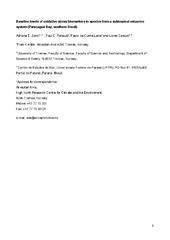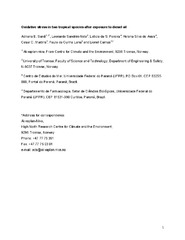Blar i forfatter "Camus, Lionel"
-
Autonomous Surface and Underwater Vehicles as Effective Ecosystem Monitoring and Research Platforms in the Arctic—The Glider Project
Camus, Lionel; Andrade, Hector; Aniceto, Ana Sofia; Aune, Magnus; Bandara, Kanchana; Basedow, Sünnje Linnéa; Christensen, Kai Håkon; Cook, Jeremy; Daase, Malin; Dunlop, Katherine Mary; Falk-Petersen, Stig; fietzek, Peter; Fonnes, Gro; Ghaffari, Peygham; Gramvik, Geir; Graves, Inger; Hayes, Daniel; Langeland, Tom; Lura, Harald; Marin, Trond Kristiansen; Nøst, Ole Anders; Peddie, David; Pederick, Joel; Pedersen, Geir; Sperrevik, Ann Kristin; Sørensen, Kai; Tassara, Luca; Tjøstheim, Sigurd; Tverberg, Vigdis; Dahle, Salve (Journal article; Tidsskriftartikkel; Peer reviewed, 2021-10-12)Effective ocean management requires integrated and sustainable ocean observing systems enabling us to map and understand ecosystem properties and the effects of human activities. Autonomous subsurface and surface vehicles, here collectively referred to as “gliders”, are part of such ocean observing systems providing high spatiotemporal resolution. In this paper, we present some of the results achieved ... -
Baseline levels of oxidative stress biomarkers in species from a subtropical estuarine system (Paranaguá Bay, southern Brazil)
Sardi Sulvarán, Adriana Eva; Renaud, Paul; Lana, Paulo Da Cunha; Camus, Lionel (Peer reviewed; Journal article; Tidsskriftsartikkel, 2016-08-10)Offshore petroleum exploration has increased the risks of oil spills in coastal tropical and subtropical habitats. Monitoring tools are needed to assess and protect environmental health. We determined baseline values of antioxidant biomarkers (CAT, SOD, GPx, GST, MDA) for five ecologically relevant species in a subtropical system in southern Brazil. Regional baseline levels are compared with literature ... -
Bioglider: an integrated glider solution for enhancing environmental knowledge
Poncon, Yves; Mortier, Laurent; Picheral, Marc; Fitzek, Peer; Hayes, Dan; Abdi, Ehsan; Zdroik, Jakub; Beszczynska-Möller, Agnieszka; Coindat, Jerome; Dunn, Muriel Barbara; Ramasco, Virginie; Thorstensen, Morten; Camus, Lionel; Priou, Pierre; Basedow, Sünnje Linnéa; Pedersen, Geir; Arbi, Tarak; Geller, Benoit (Journal article; Tidsskriftartikkel; Peer reviewed, 2023-12-11)This paper presents a technological solution for the observation and monitoring of the marine ecosystem. Three complementary devices, one optic imaging and one scientific acoustic instrument as well as one acoustic communication modem, have been integrated on glider platforms, providing qualitative and quantitative zooplankton and fish ecology observations, which are especially relevant in Nordic ... -
Effects of acute exposure to dispersed oil and burned oil residue on long-term survival, growth, and reproductive development in polar cod (Boreogadus saida)
Bender, Morgan Lizabeth; Frantzen, marianne; Camus, Lionel; Le Floch, Sebastien; Palerud, Jocelyn Hernandez; Nahrgang, Jasmine (Journal article; Tidsskriftartikkel; Peer reviewed, 2018-09-05)The present study investigates the potential long-term physiological effects on maturing polar cod (<i>Boreogadus saida</i>), an Arctic key species, after an acute exposure (48 h) to environmentally realistic concentrations of either mechanically dispersed oil (MDO), chemically dispersed oil (CDO) or burned oil residues (BO) (N = 58–60 per treatment). Following exposure, fish were monitored in a ... -
Evidence of separate influence of moon and sun on light synchronization of mussel's daily rhythm during the polar night
Tran, Damien; Andrade Rodriguez, Hector Antonio; Camus, Lionel; Leopold, Peter; Ballantine, Carl; Berge, Jørgen; Durier, Guillaume; Sow, Mohamedou; Ciret, Pierre (Journal article; Tidsskriftartikkel; Peer reviewed, 2023-02-09)Marine organisms living at high latitudes are faced with a light climate that undergoes drastic annual changes, especially during the polar night (PN) when the sun remains below the horizon for months. This raises the question of a possible synchronization and entrainment of biological rhythms under the governance of light at very low intensities. We analyzed the rhythms of the mussel <i>Mytilus</i> ... -
Growth and behaviour of blue mussels, a re-emerging polar resident, follow a strong annual rhythm shaped by the extreme high Arctic light regime: Mussels' growth and behavior in Arctic
Tran, Damien; Andrade Rodriguez, Hector Antonio; Durier, Guillaume; Ciret, Pierre; Leopold, Peter; Sow, Mohamedou; Ballantine, Carl; Camus, Lionel; Berge, Jørgen; Perrigault, Mickael (Journal article; Tidsskriftartikkel; Peer reviewed, 2020-10-14)Polar regions are currently warming at a rate above the global average. One issue of concern is the consequences on biodiversity in relation to the Northward latitudinal shift in distribution of temperate species. In the present study, lasting almost two years, we examined two phenological traits, i.e. the shell growth and behavioural rhythm of a recently re-established species in the high Arctic, ... -
In the darkness of the polar night, scallops keep on a steady rhythm
Tran, Damien; Sow, Mohamedou; Camus, Lionel; Ciret, Pierre; Berge, Jørgen; Massabuau, Jean-Charles (Journal article; Tidsskriftartikkel; Peer reviewed, 2016)Although the prevailing paradigm has held that the polar night is a period of biological quiescence, recent studies have detected noticeable activity levels in marine organisms. In this study, we investigated the circadian rhythm of the scallop Chlamys islandica by continuously recording the animal’s behaviour over 3 years in the Arctic (Svalbard). Our results showed that a circadian rhythm persists ... -
Inverse method applied to autonomous broadband hydroacoustic survey detects higher densities of zooplankton in near-surface aggregations than vessel-based net survey
Dunn, Muriel Barbara; Pedersen, Geir; Basedow, Sünnje Linnéa; Daase, Malin; Falk-Petersen, Stig; Bachelot, Loic; Camus, Lionel; Geoffroy, Maxime (Journal article; Tidsskriftartikkel; Peer reviewed, 2022-11-10)Throughout all oceans, aggregations of zooplankton and ichthyoplankton appear as horizontal sound scattering layers (SSLs) when detected with active acoustic techniques. Quantifying the composition and density of these layers is prone to sampling biases. We conducted a net and trawl survey of the epipelagic fauna in northern Norway (70˚N) in June 2018 while an autonomous surface vehicle equipped ... -
Model-informed classification of broadband acoustic backscatter from zooplankton in an in situ mesocosm
Dunn, Muriel Barbara; McGowan-Yallop, Chelsey; Pedersen, Geir; Falk-Petersen, Stig; Daase, Malin Hildegard Elisabeth; Last, Kim; Langbehn, Tom; Fielding, Sophie; Brierley, Andrew S.; Cottier, Finlo Robert; Basedow, Sünnje Linnéa; Camus, Lionel; Geoffroy, Maxime (Journal article; Tidsskriftartikkel; Peer reviewed, 2023-12-07)Classification of zooplankton to species with broadband echosounder data could increase the taxonomic resolution of acoustic surveys and reduce the dependence on net and trawl samples for ‘ground truthing’. Supervised classification with broadband echosounder data is limited by the acquisition of validated data required to train machine learning algorithms (‘classifiers’). We tested the hypothesis ... -
Oxidative stress in two tropical species after exposure to diesel oil
Sardi Sulvarán, Adriana Eva; Sandrini-Neto, Leonardo; da S. Pereira, Leticia; Silva de Assis, Helena; Martins, Cesar C.; Lana, Paulo Da Cunha; Camus, Lionel (Peer reviewed; Journal article; Tidsskriftsartikkel, 2016-08-03)Recent offshore petroleum exploration has increased the risks of oil spills worldwide. We investigated biomarker responses to diesel oil exposure in two tropical and subtropical species, the clam Anomalocardia flexuosa and the polychaete Laeonereis culveri. Animals were exposed to oil-spiked sediment at two different concentrations (0.5 L and 1.0 L m−2). Activities of antioxidant enzymes catalase ... -
Seasonal ecology in ice-covered Arctic seas - Considerations for spill response decision making
Aune, Magnus; Aniceto, Ana Sofia; Biuw, Martin; Daase, Malin; Falk-Petersen, Stig; Leu, Eva; Ottesen, Camilla; Sagerup, Kjetil; Camus, Lionel (Journal article; Tidsskriftartikkel; Peer reviewed, 2018-09-05)Due to retreating sea ice and predictions of undiscovered oil and gas resources, increased activity in Arctic shelf sea areas associated with shipping and oil and gas exploration is expected. Such activities may accidentally lead to oil spills in partly ice-covered ocean areas, which raises issues related to oil spill response. Net Environmental Benefit Analysis (NEBA) is the process that the response ...


 English
English norsk
norsk









